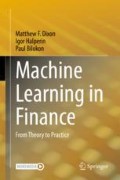Abstract
This chapter presents a powerful class of probabilistic models for financial data. Many of these models overcome some of the severe stationarity limitations of the frequentist models in the previous chapters. The fitting procedure demonstrated is also different—the use of Kalman filtering algorithms for state-space models rather than maximum likelihood estimation or Bayesian inference. Simple examples of hidden Markov models and particle filters in finance and various algorithms are presented.
Access this chapter
Tax calculation will be finalised at checkout
Purchases are for personal use only
Notes
- 1.
Dynamic Bayesian networks models are a graphical model used to model dynamic processes through hidden state evolution.
- 2.
With the exception of heteroscedastic modeling in Chap. 6.
- 3.
An acronym for Bayesian inference Using Gibbs Sampling.
- 4.
Sometimes the Gibbs sampler is referred to as data augmentation following this paper.
References
Black, F. (1976). Studies of stock price volatility changes. In Proceedings of the Business and Economic Statistics Section.
Chen, Z. (2003). Bayesian filtering: From Kalman filters to particle filters, and beyond. Statistics,182(1), 1–69.
Crisan, D., & Míguez, J. (2013). Nested particle filters for online parameter estimation in discrete-time state-space Markov models. ArXiv:1308.1883.
Gelfand, A. E., & Smith, A. F. M. (1990, June). Sampling-based approaches to calculating marginal densities. Journal of the American Statistical Association,85(410), 398–409.
Geman, S. J., & Geman, D. (1984). Stochastic relaxation, Gibbs distributions, and the Bayesian restoration of images. IEEE Transactions on Pattern Analysis and Machine Intelligence,6, 721–741.
Gilks, W. R., & Wild, P. P. (1992). Adaptive rejection sampling for Gibbs sampling, Vol. 41, pp. 337–348.
Gill, P. E., Murray, W., & Wright, M. H. (1982). Practical optimization. Emerald Group Publishing Limited.
Gordon, N. J., Salmond, D. J., & Smith, A. F. M. (1993). Novel approach to nonlinear/non-Gaussian Bayesian state estimation. In IEE Proceedings F (Radar and Signal Processing).
Green, P. J. (1995). Reversible jump Markov chain Monte Carlo computation and Bayesian model determination. Biometrika,82(4), 711–32.
Hastings, W. K. (1970). Monte Carlo sampling methods using Markov chains and their applications. Biometrika,57(1), 97–109.
Kim, S., Shephard, N., & Chib, S. (1998, July). Stochastic volatility: Likelihood inference and comparison with ARCH models. The Review of Economic Studies,65(3), 361–393.
Kitagawa, G. (1993). A Monte Carlo filtering and smoothing method for non-Gaussian nonlinear state space models. In Proceedings of the 2nd U.S.-Japan Joint Seminar on Statistical Time Series Analysis (pp. 110–131).
Kitagawa, G. (1996). Monte Carlo filter and smoother for non-Gaussian nonlinear state space models. Journal of Computational and Graphical Statistics,5(1), 1–25.
Lunn, D. J., Thomas, A., Best, N. G., & Spiegelhalter, D. (2000). WinBUGS – a Bayesian modelling framework: Concepts, structure and extensibility. Statistics and Computing,10, 325–337.
Malik, S., & Pitt, M. K. (2009, April). Modelling stochastic volatility with leverage and jumps: A simulated maximum likelihood approach via particle filtering. Warwick Economic Research Papers 897, The University of Warwick, Department of Economics, Coventry CV4 7AL.
Malik, S., & Pitt, M. K. (2011a, February). Modelling stochastic volatility with leverage and jumps: A simulated maximum likelihood approach via particle filtering. document de travail 318, Banque de France Eurosystème.
Malik, S., & Pitt, M. K. (2011b). Particle filters for continuous likelihood evaluation and maximisation. Journal of Econometrics,165, 190–209.
Metropolis, N., Rosenbluth, A. W., Rosenbluth, M. N., Teller, A. H., & Teller, E. (1953). Equation of state calculations by fast computing machines. Journal of Chemical Physics,21.
Meyer, R., & Yu, J. (2000). BUGS for a Bayesian analysis of stochastic volatility models. Econometrics Journal,3, 198–215.
Naesseth, C. A., Lindsten, F., & Schön, T. B. (2015). Nested sequential Monte Carlo methods. In Proceedings of the 32nd International Conference on Machine Learning.
Pitt, M. K., Malik, S., & Doucet, A. (2014). Simulated likelihood inference for stochastic volatility models using continuous particle filtering. Annals of the Institute of Statistical Mathematics,66, 527–552.
Ritter, C., & Tanner, M. A. (1992). Facilitating the Gibbs sampler: The Gibbs stopper and the Griddy-Gibbs sampler. Journal of the American Statistical Association,87(419), 861–868.
Sayed, A. H. (2008). Adaptive filters. Wiley-Interscience.
Spiegelhalter, D., Thomas, A., Best, N. G., & Gilks, W. R. (1996, August). BUGS 0.5: Bayesian inference using Gibbs sampling manual (version ii). Robinson Way, Cambridge CB2 2SR: MRC Biostatistics Unit, Institute of Public Health.
Tanner, M. A., & Wong, W. H. (1987, June). The calculation of posterior distributions by data augmentation. Journal of the American Statistical Association,82(398), 528–540.
Taylor, S. J. (1982). Time series analysis: theory and practice. Chapter Financial returns modelled by the product of two stochastic processes, a study of daily sugar prices, pp. 203–226. North-Holland.
Vega, L. R., & H. Rey (2013). A rapid introduction to adaptive filtering. Springer Briefs in Electrical and Computer Engineering. Springer.
Yu, J. (2005). On leverage in a stochastic volatility model. Journal of Econometrics,127, 165–178.
Author information
Authors and Affiliations
Appendix
Appendix
Python Notebooks
The notebooks provided in the accompanying source code repository are designed to gain familiarity with how to implement the Viterbi algorithm and particle filtering for stochastic volatility model calibration. Further details of the notebooks are included in the README.md file.
Rights and permissions
Copyright information
© 2020 Springer Nature Switzerland AG
About this chapter
Cite this chapter
Dixon, M.F., Halperin, I., Bilokon, P. (2020). Probabilistic Sequence Modeling. In: Machine Learning in Finance. Springer, Cham. https://doi.org/10.1007/978-3-030-41068-1_7
Download citation
DOI: https://doi.org/10.1007/978-3-030-41068-1_7
Published:
Publisher Name: Springer, Cham
Print ISBN: 978-3-030-41067-4
Online ISBN: 978-3-030-41068-1
eBook Packages: Mathematics and StatisticsMathematics and Statistics (R0)

